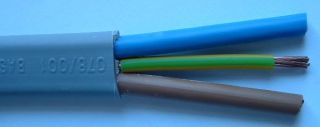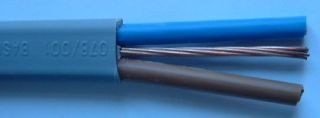Cable is a permanently fixed wire that is used to supply electricity to the different circuits in the home, these circuits can be the Lighting or socket circuit or shower / cooker etc. The more current a circuit uses the thicker the wire has to be, otherwise the wire could melt if a fuse of the incorrect amperage is used to protect the circuit.
The type of cable that is used for indoor domestic wiring is known as twin core & earth, this comprises of three wires, two of which are covered with a coloured insulating material and the earth wire (often called the CPC or central protective conductor) which runs between the two insulated wires. The insulated wires are coloured either Red / Brown for live and Black / Blue for neutral. For more information on wiring colours please see here. These three wires are covered in oval shaped PVC which is normally white or grey.
| Before working on any electrical circuit you must ensure that it is isolated correctly and cannot accidentally be switched back on. Please read the article on safe isolation procedures before doing any electrical work. If you are not 100% certain what you are doing call a qualified electrician. Building regulations are changing all the time and modifying your home electrics could be against new rules and could invalidate your home insurance, if in doubt check first! |

Here you can see twin core and earth cable that has had the outer insulation removed, the neutral conductor is Blue, the Live is brown and the earth is bare. Green and Yellow earth sleeving must be placed over the earth wire!

Here you can see that Yellow and Green earth sleeving has been used to identify the earth conductor.
The carrying capacity of any cable can be greatly effected by several factors, such as it's length. A long length of cable would often require that a thicker cable size to be used. Calculating the thickness of cable is best left to a electrician as it can be very complex, things such as diversity and voltage drop must be calculated for! Often electricians work in electrical wholesalers and can advise you on the correct thickness of cable to use and the current regulations. Don't guess or take chances, personally I always use a thicker cable than is recommended for cookers and showers I use 10mm2 this is because I may wish to swap the cooker or shower at a later date for a higher amperage one and if a smaller thickness cable had been used it would need re-wiring again! In extreme circumstances 16mm2 cable may be required.
1.0mm2 Twin core and earth

1.0mm2 is used for lighting circuits up to a maximum of 1200 watts. Three core and earth wire is available to enable two/ three way switching
2.5mm2 Twin core and earth

2.5mm2 is used for socket ring circuits or for a immersion heater / storage heater up to 20 AMPS
4.0mm2 Twin core and earth

4.0mm2 is for some shower circuits and used for radial socket circuits
6.0mm2 Twin core and earth

6.0mm2 is for 30 AMP circuits and is used for cookers up to 13KW and some shower circuits
10mm2 Twin core and earth

10mm2 is used for cooker circuits above 13KW and up to 45 Amp load. High powered showers often use 10mm2 cable

Earthing wire is used for earthing the electricity supply in the home. Currently the thickness of earthing wires for domestic wiring are as follows-16mm2 - Main bond between the consumer unit and the supply earth.
10mm2 - Main bond from the consumer unit to incoming metal water, gas and oil service pipes.
4.0mm2 - Supplementary bonding -Bathroom- metal sinks, taps, radiators, metal baths, ETC.



